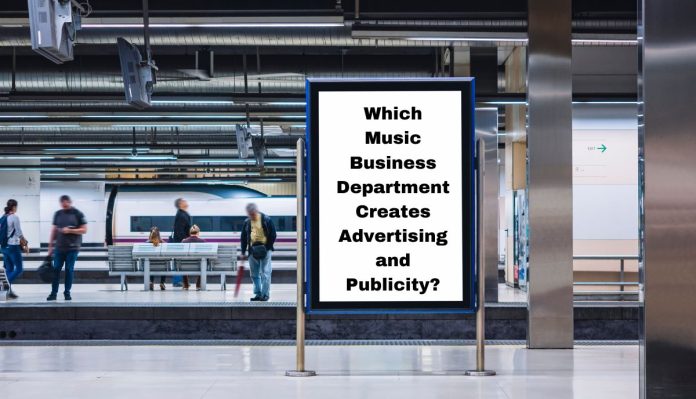The music business is a complex landscape of artistry, creativity, and business savvy. From songwriters to producers, vocalists to managers, and engineers to publicists, the music industry is made up of a number of interlocking departments that work together to create a successful product. Among these departments, one that is essential for success is the advertising and publicity department, which is responsible for promoting an artist’s music and creating an audience for it. In this blog, we’ll take an in-depth look at how this important department works and how it can help artists reach their goals.
Overview of Music Business Departments
The music business is composed of many different departments, each with their own unique roles and responsibilities. From marketing to distribution to A&R, having a clear understanding of the different departments and how they work together is essential for anyone looking to break into the music industry.
- Marketing
The marketing department is responsible for promoting the music and artists, as well as creating awareness and interest in the artist and their music. This involves creating promotional campaigns, designing advertising materials, and creating press releases. They also work with radio stations and other media outlets to get the music played and promoted.
- Distribution
The distribution department is responsible for making sure the music gets out to the public. This includes working with physical and digital distributors to make sure the music is available for sale online and in stores. They are also responsible for making sure that the music is available for streaming, as well as for finding ways to get the music out to fans through events and other promotional activities.
- A&R
The A&R department is responsible for finding and developing new talent. This involves scouting talent, listening to demos, and finding artists that fit the label’s sound and vision. They also work with the artist to develop their sound and craft their identity.
- Finance
The finance department is responsible for managing the finances of the label. This includes creating budgets, keeping track of royalties, and handling the finances for any promotional activities. They also help to negotiate contracts and other financial deals for the label and the artist.
- Legal
The legal department is responsible for handling any contractual issues that arise between the artist and the label. They will also handle any legal issues that come up with the music, whether it’s copyright issues or other legal matters.
These are just a few of the departments in the music business. Each one is essential to ensure that the artist’s music is successful and that the label is profitable. Understanding how each department works and interacts with each other is essential to success in the music industry.
Types of Advertising Strategies
Advertising is a critical part of any successful business and is essential to ensure that your company is visible in the marketplace. Advertising strategies vary greatly, depending on the company’s goals and target audience. Here, we’ll discuss the types of advertising strategies businesses can use to reach their desired customers and achieve their business objectives.
- Traditional Advertising
Traditional advertising is the oldest form of advertising and includes television, radio, newspaper, magazines, and billboards. Traditional advertising is still a preferred choice for some businesses because it can reach a wide audience and can be used in a variety of ways, such as print ads, television commercials, radio spots, and more. Traditional advertising is also relatively inexpensive compared to other types of advertising.
- Digital Advertising
Digital advertising is the newest form of advertising and includes online and mobile advertising. This type of advertising is becoming increasingly popular as businesses have access to a large, targeted audience on the internet. Digital advertising provides businesses with the opportunity to reach their customers in an effective and affordable way. Digital advertising includes pay-per-click (PPC) ads, banner ads, social media ads, search engine optimization (SEO) campaigns, and more.
- Social Media Advertising
Social media advertising is one of the most popular forms of advertising today and is a great way to reach a large number of potential customers. Social media advertising enables businesses to target their desired audience and customize their ads to their needs. Popular platforms, such as Facebook and Instagram, allow businesses to reach even more potential customers. Additionally, social media advertising is usually very affordable and is one of the most cost-effective forms of advertising.
- Influencer Marketing
Influencer marketing is a type of digital marketing that involves partnering with influencers or celebrities who can promote your product or service to their followers and fans. Influencer marketing is an effective way to reach a large and engaged audience. It is also relatively affordable and can be tailored to meet your budget.
- Content Marketing
Content marketing is a type of advertising that focuses on creating and distributing content that is relevant to your target audience. The aim of content marketing is to create content that is interesting and valuable to your customers. Content marketing can be used to promote a brand, increase sales, and build customer loyalty. Content marketing can include blog posts, infographics, videos, and more.
- Guerilla Marketing
Guerilla marketing is an unconventional form of marketing that involves using creative and unique tactics to attract attention and generate interest in a product or service. It is often used by businesses that have a limited budget or that are trying to reach a niche target audience. Guerilla marketing tactics can include street art, surprise events, and other creative methods.
Function of Advertising and Publicity Departments
Advertising and publicity are two of the most important aspects of any business, and the departments responsible for them are essential to a company’s success. Advertising and publicity departments play a key role in creating and maintaining a business’s brand, reach, and reputation, and their functions should not be overlooked.
Advertising is the process of creating a message to promote a product or service to potential customers. It involves creating an advertisement, such as a commercial, print ad, or radio spot, and implementing a strategy to reach the target audience. Advertising campaigns use a variety of media, such as television, radio, newspapers, magazines, and the internet, to reach their target markets. The advertising department is responsible for creating the ads, ensuring they are seen by the right people, and tracking the results of the campaign.
Publicity is the process of getting the word out about a product or service to the public. It involves using press releases, public relations campaigns, and other methods to spread the word about a business. The publicity department is responsible for developing positive relationships with the media, creating press releases, and managing the company’s public image.
The functions of the advertising and publicity departments are essential to any successful business. Advertising and publicity can be used to create brand awareness, increase sales, and drive customer loyalty. They can also help to protect a company’s reputation by providing positive publicity when a company is facing negative press.
Advertising and publicity departments can also be used to create competitive advantages. They can help a business stand out from its competitors by creating unique messages and campaigns that appeal to their target market. By staying up to date with the latest trends and technologies, they can also help a business remain competitive in its market.
Advertising and publicity departments are key to a business’s success and should be given priority when an organization is developing its marketing budget. Without proper advertising and publicity, it can be difficult to reach potential customers and build a positive reputation. The functions of the advertising and publicity departments should never be overlooked, as they are essential to any business’s success.
Benefits of Advertising and Publicity in Music Business
Here are some of the key benefits of advertising and publicity in the music business:
- Increased Visibilit
Advertising and publicity can help to increase the visibility of a musician or band, which can lead to more fans and listeners. Advertising campaigns can be targeted to specific demographics, so the right message can reach the right audiences. Additionally, publicity campaigns can be used to get more exposure for releases, tours, and other activities.
- Improved Brand Recognition
Advertising and publicity can help to increase brand recognition. Advertising campaigns can be used to create an emotional connection with potential fans and help to create an identity for the artist. Publicity can also help to build a positive image for the artist and create a more recognizable name.
- Improved Profitability
Advertising and publicity can lead to increased ticket and product sales, which can result in higher profits for the band. Advertising campaigns can be used to drive ticket sales and increase product sales, while publicity can be used to generate more exposure for the artist and their music.
- Increased Reach
Advertising and publicity can help to reach more people than ever before. Advertising can be used to reach specific target audiences, while publicity can be used to generate more exposure for the artist and their music.
Conclusion
In conclusion, the Music Business Department plays an important role in advertising and publicity for the music industry. Through effective use of marketing strategies, the department can help create, distribute, and manage promotional materials to reach potential consumers and increase public awareness of the music industry. Furthermore, the impacts of advertising and publicity are far-reaching, from improving the public perception of the music industry to boosting sales and increasing profits. With the right strategies, the Music Business Department can help ensure that the music industry continues to thrive and remain relevant in the modern world. Read more for these type of blogs.

